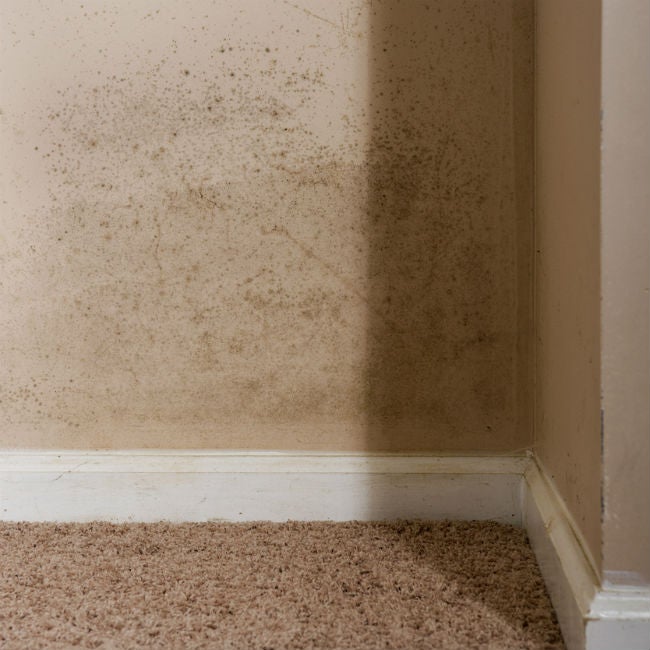解决了!如何解决模具在墙上
Safely remove unsightly and potentially hazardous mold from the bathroom and other moisture-prone zones—and keep it at bay—with these easy methods.

Photo: istockphoto.com
Q: Ugh! I’ve recently discovered ugly patches of mold on the walls in my bathroom. Is it dangerous? How do I get rid of it?
A:It’s an all-too-common problem in any area of the home where moisture levels tend to be high: splotches of mold growing on the walls or ceiling. While mold can sprout anywhere along a wall, it’s most often found either up high near the ceiling, down low near the floor, or creeping along edges of trim or baseboards. This frustrating and potentially hazardous problem ismostcommonin bathroomswith frequently used showers or tubs, but can also affect damp basements, kitchens, or laundry rooms. If conditions are damp, ventilation is poor, and temperatures are high, airborne, invisible mold spores—found virtually everywhere—happily settle in and grow.
RELATED:How To: Test for Mold
The most feared type of mold isStachybotrys chartarum, typically referred to as black mold, which can cause chronic respiratory irritation, headaches, and persistent fatigue. According to theCenters for Disease Control and Prevention, black mold requires constant moisture for growth—not just intermittent moisture from the shower—so it’s likelier that your problem is caused by another less toxic variety of mold. That said, a severe mold situation can lead to or exacerbate respiratory or immune system issues.
If mold is growing in an area that remains wet, it’s best to consult with an expert in mold remediation for professional cleaning services. The good news is that you should be able to clear up most everyday mold problems yourself. Keep reading to learn techniques for curing the common mold.

Photo: istockphoto.com
Remove mold stains from walls.
Mix a solution of one partbleachto three parts water in a spray bottle, and thoroughly saturate the moldy areas of the wall. Open a window and/or keep a fan running as you work; bleach fumes are unpleasant and can be irritating to the lungs. Let the bleach soak into the mold on the walls for several minutes, then use a scrub brush to remove the stains. If the stains are extensive or deep, you may need to repeat the process to remove all discoloration.
RELATED:The Dark, Dirty Truth About Household Mold (And How to Rid Yourself of It)
Kill mold on walls.
While bleach works well to kill surface fungus and remove the ugly marks on the walls caused by mold, it doesn’t penetrate deeply into the drywall and so it leaves the mold’s “roots” undisturbed. That means the problem is likely to reoccur, sometimes within days. To kill moldbeneaththe surface, simply spray undiluted white vinegar onto the affected area and let it dry. Don’t worry about the odor; the smell will dissipate once the vinegar is completely dry.

Photo: istockphoto.com
Prevent future mold growth.
Once you’ve removed all mold on the walls, keep those surfaces looking good with a few preventative measures:
- Wipe up puddles or spills immediately.
- After a shower or bath, leave the bathroom door open withthe ventilation fanrunning—or the bathroom window open—for at least 20 minutes to allow humidity to diminish.
- Keep an eye out for plumbing leaks. Fix them right away—most types of mold only need around 24 to 48 hours of moisture before spores start to multiply, and black mold becomes more of a possibility the longer water leaks are left untended.
- Spread out damp towels so they dry quickly.
- If possible, shower with the bathroom door open so condensation doesn’t build up in the enclosed space.
- Set a canister of moisture-absorbing desiccant—these generally contain eithersilica gelor salt—in a corner of your bathroom, or run a dehumidifier if you live in a particularly humid climate.
- Squeegee shower walls and glass doors after every use to help remove the moisture that encourages the growth of mold on your walls and also prevent unsightly hard-water and soap-scum buildup.
- Usemold-resistant paint in the bathroomor mold-prone areas when it’s time to repaint or remodel.
- Clean the bathroom weekly with your favorite disinfecting product, whether that be bleach, vinegar, or a commercial cleaner, and remember to scrub underneath bottles of shampoo and other shower necessities where mold spores tend to linger.






